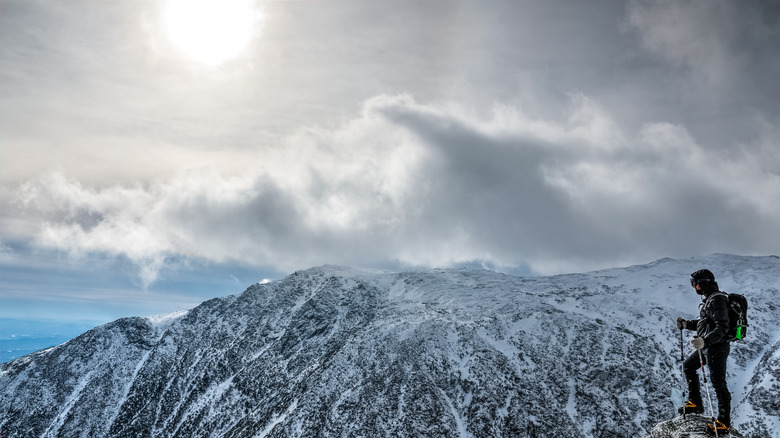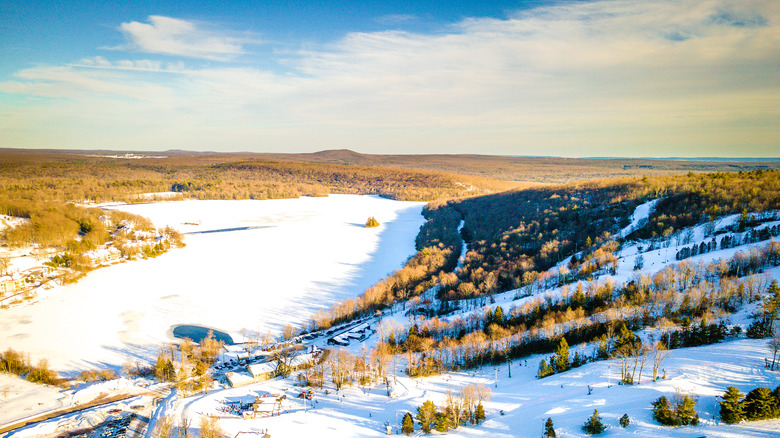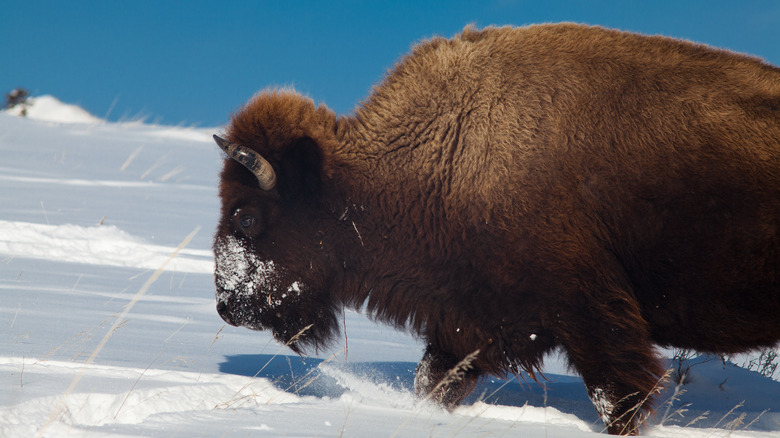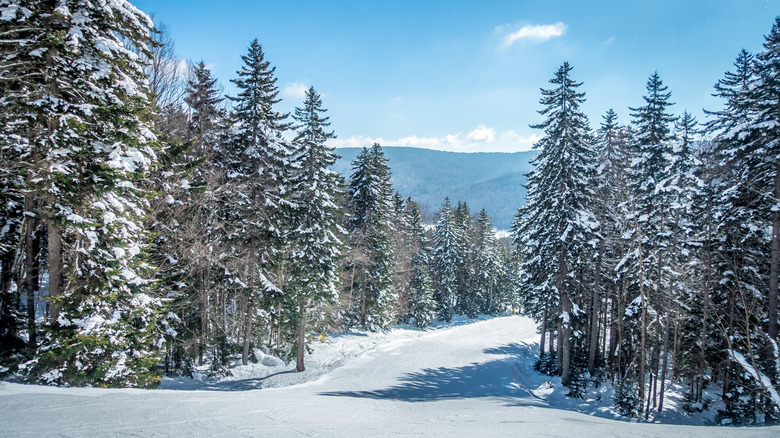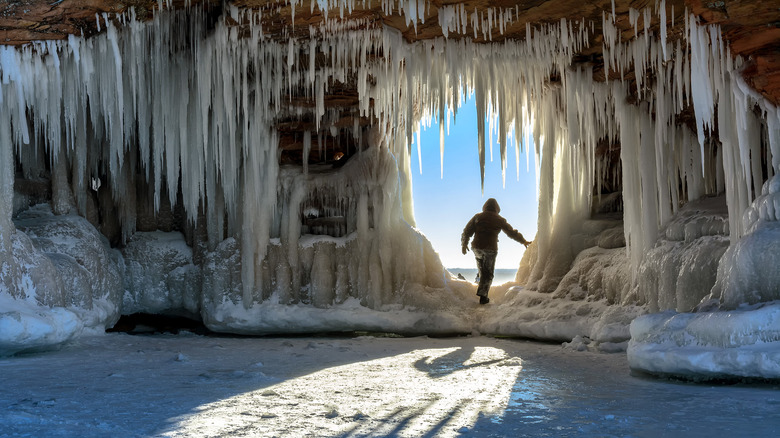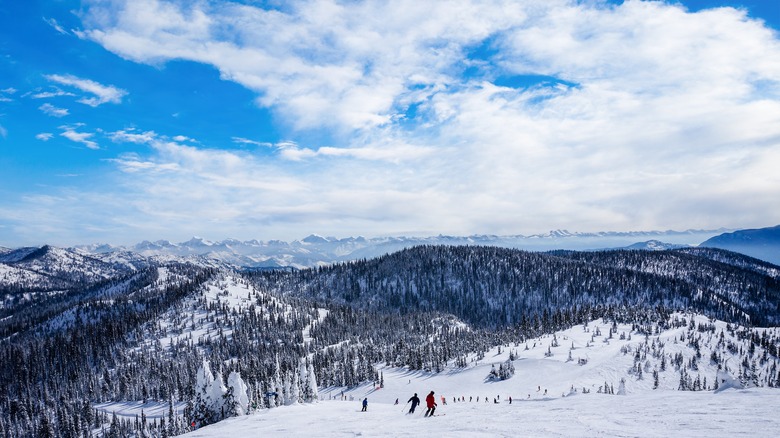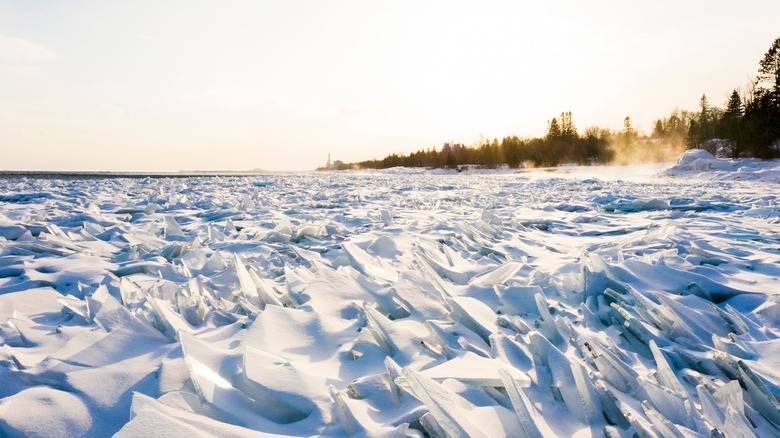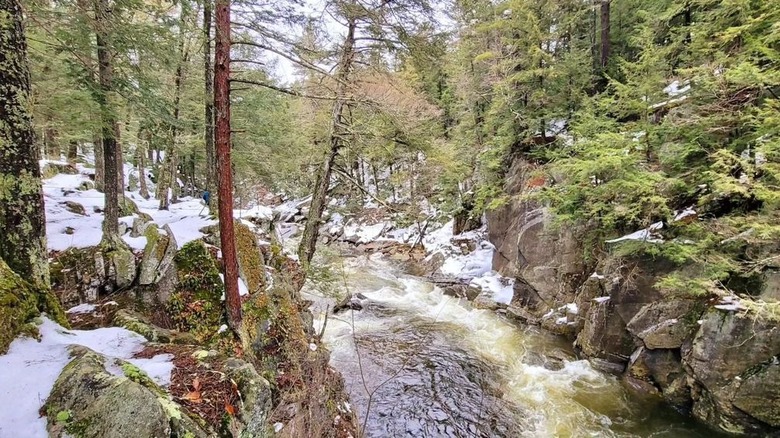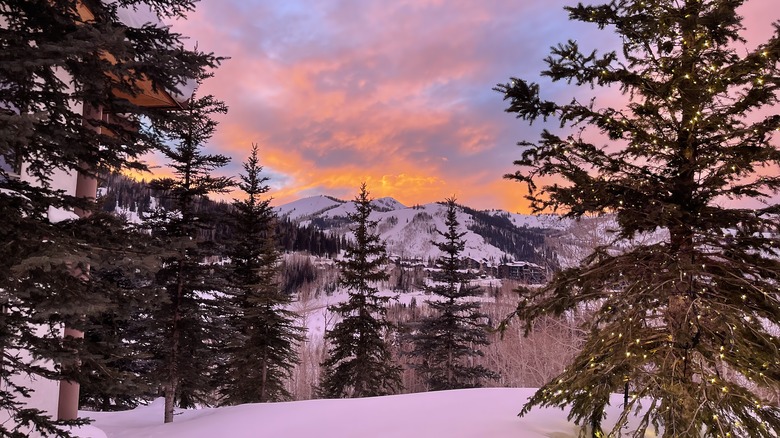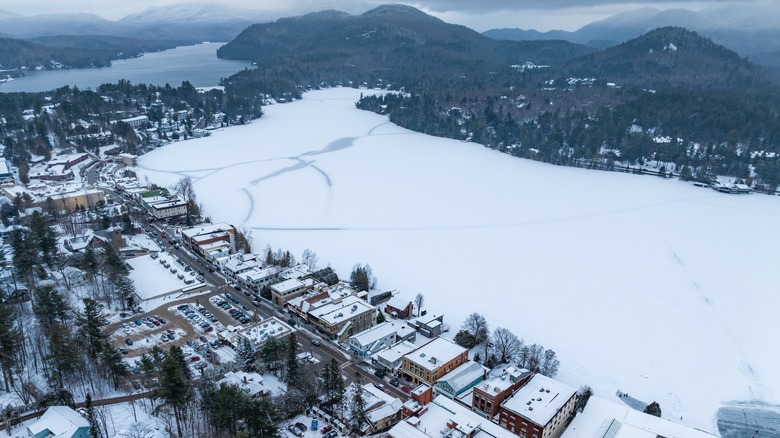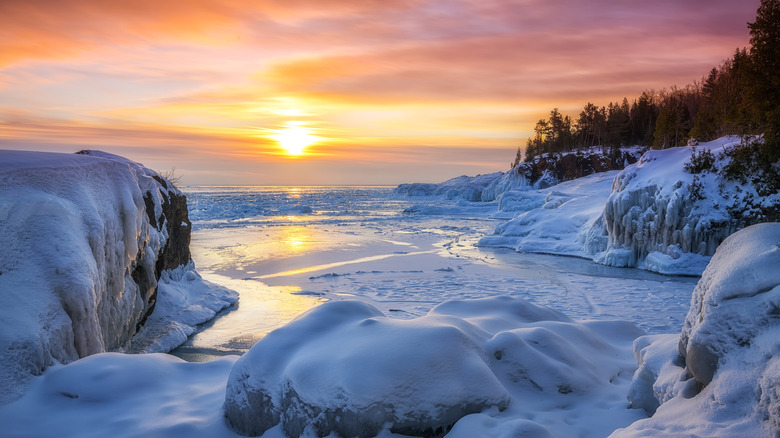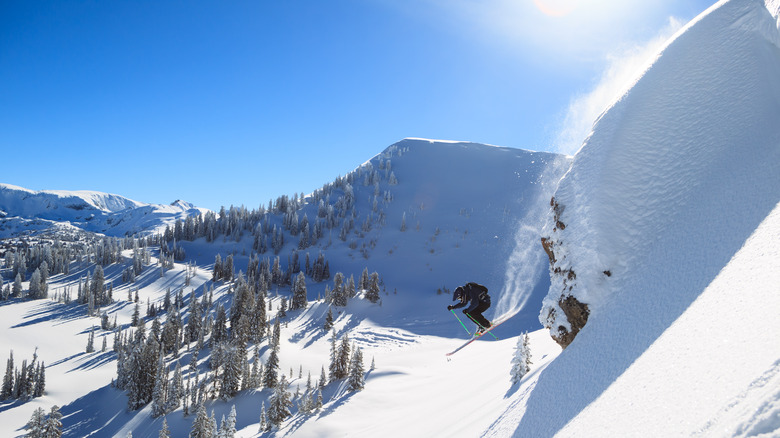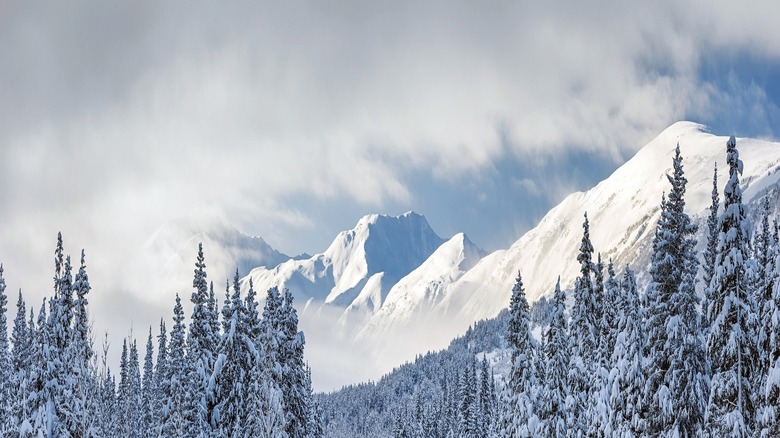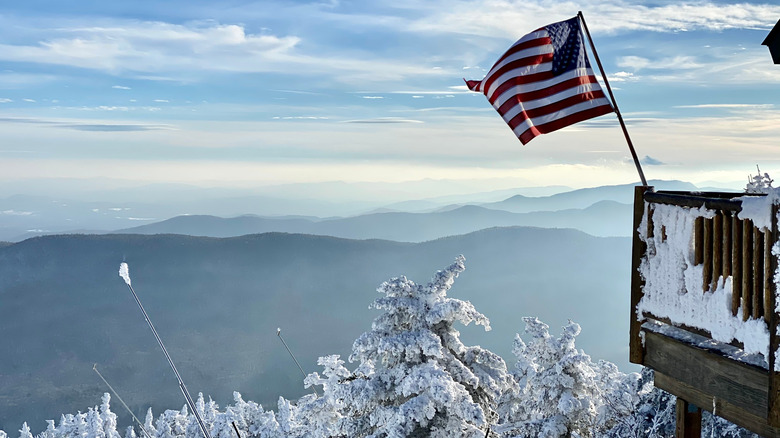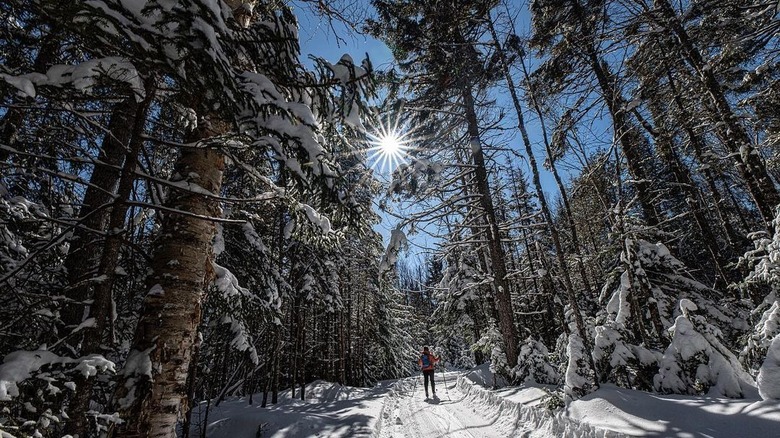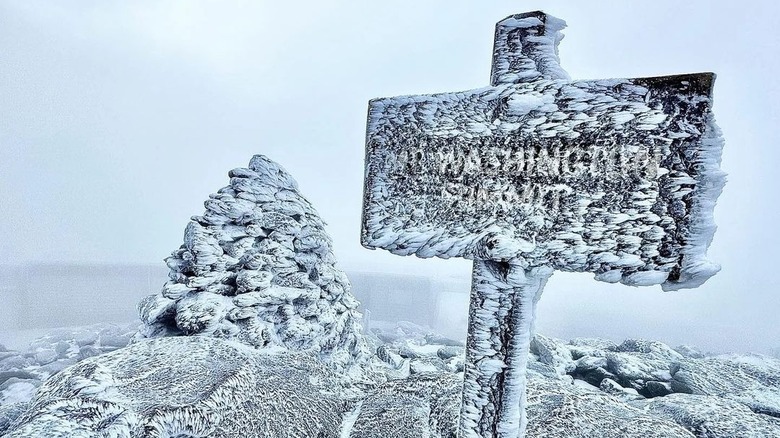15 Snowiest States To Visit For Skiing, Snowboarding, & More
According to On The Snow, an average of 112 inches of snow falls in the United States every year. Of course, some states get more snow than average, others get less, and some almost none at all. Of America's snowiest states (determined with data from WiseVoter and World Population Review), each has dealt with historic winter blasts throughout history, though some parts of a given state can get hit harder than others. That said, snow is a classic part of the winter experience, even if grizzled veterans of winter complain every year that they've "just had it" with the white stuff.
Even so, most disgruntled winter sufferers eagerly participate in snowy activities. Why? Because the snowiest states offer amazing winter fun in spades. From skiing (both cross-country and alpine) to hiking and snowshoeing, not to mention snowboarding, snowmobiling, ice climbing, and more, there are a slew of wonderful winter activities spread out across the snowiest states in the United States. Here are those states, in order from the least snowy to the most snow-covered, along with some of the fantabulous, wintry things you can do in them.
Pennsylvania
Pennsylvania averages more than 42 inches of snowfall per year, and the snowiest part of Pennsylvania stretches over the Allegheny Mountain Range. Pennsylvania's most recent record-breaking snowfall occurred in February 2010, when "Snowmageddon" walloped Philadelphia with 44 inches of snow. Pittsburgh was covered with 21 inches of snow, too, making it one of the worst storms to hit Pennsylvania in decades.
Winter activities abound in the Keystone State, including both downhill and cross-country ski spots. The Poconos' Blue Mountain Ski Resort is a modern alpine ski spot with varied terrain, fast chair lifts, and a cozy apres ski environment, where lift tickets start at $54. Elk Mountain is smaller but more serene, with some of the best snow in the Poconos; lift tickets start at $40. Pennsylvania also has lots of cross-country ski options, with the Great Allegheny Passage featuring more than 150 miles of cross-country ski trails snaking through Ohiopyle State Park.
If hurtling down a hill is more your thing than skiing, fear not — Pennsylvania's got you covered. Heritage Hills Golf Course features a 900-foot tubing hill. We'd tell you to buckle up, but there aren't any seatbelts on snow tubes, silly goose.
North Dakota
North Dakota averages just over 43 inches of snow per year, making it the 14th snowiest state in the Union. The Peace Garden State's most recent record-breaking snowstorm occurred in April of 1997 when an early spring blizzard dumped a massive amount of snow (2 feet in some areas) over a three-day span. The storm — which caused power outages, stranded drivers, and killed more than 100,000 heads of cattle — brought North Dakota's snow total for the year up to 101.4 inches, a record that still stands.
Witnessing North Dakota during the winter is a thing of beauty. Take advantage of the many hiking and snowshoeing opportunities, especially in Cross State Park, with more than 17 miles of trails ready to be explored. You can rent equipment in the park and even stay in a yurt to cozy up after trudging through the snow. If you'd rather not get any exercise but still want to explore, North Dakota sports nearly 3,000 miles of snowmobiling trails crisscrossing the state. And if you're into wildlife? You are in luck. Theodore Roosevelt National Park, in the Badlands, is a known spot for seeing magnificent wildlife in its natural element. Keep your eyes peeled for bison, coyotes, mule deer, and other creatures.
West Virginia
In total, West Virginia averages just over 44 inches of snow annually. The Mountain State is — surprise — mountainous, with its southern portion averaging nearly 70 inches of snow per year. Its most recent big snowstorm dumped between 8 and 20 inches of snow in and around Charleston, the state capital, in early May of 2023. This snowfall shattered West Virginia's May snowfall record.
One of West Virginia's most unique winter activities is sledding ($28 for ticket and sled rental) in Blackwater Falls State Park, featuring the longest sled run on the East Coast. You'll take in stunning mountain views on your ride down. Best of all? There's a conveyor belt to bring you and your sled back up to the top, so no one will be the wiser as to the sub-optimal physical shape you're in.
If you're in better shape, West Virginia has some excellent downhill skiing and snowboarding to take advantage of. Snowshoe Mountain (lift tickets start at $92), nestled amid the Appalachian Mountain Range, offers some of the state's best alpine skiing. If you're in really good shape (or even if not), hit up White Grass Touring Center to cross-country ski in the Tucker and Canaan Valleys, only some of the best cross-country ski terrain in the country.
Wisconsin
Wisconsin gets its fair share of winter, averaging just over 46 inches of snow per year. Northern Wisconsin's Lake Superior shoreline averages 97 inches of snow per year. However, the biggest recent blizzard to hit Wisconsin made landfall off Lake Michigan in April 2018, pummelling Green Bay with between 15 and 30 inches of snow and 45 mph winds. Roads were impassable, power was cut, barn roofs collapsed, and Lake Michigan pounded the shoreline with waves between 10 and 15 feet high.
Skiers and snowboarders can head to Granite Peak (lift tickets start at $109), with its nearly 70 runs and terrain for all levels. If you despise uncomfortable ski boots, check out the Superior Ice Festival, which runs every January and features ice sculptures, a snowslide, fat bike tours, and lots of food.
If you're looking for a bit more winter wildness, the cheeseheads have you covered. Drummond's Bar Stool Races, running every February (Drummond is about three hours northeast of Minneapolis), is a hoot, with money raised for charity. Competitors jerry-rig bar stools with skis, poles, and handles and then race down a hill. Registration is $30, or you can keep your sanity and just watch.
Montana
Montana averages just over 49 inches of snow per year, though Big Sky Country's snowiest parts are its western and southern regions, averaging 129 inches of snow per season. The biggest snowstorm in the last 50 years hit Montana in February 1986, when almost 5 feet of snow fell on the state. An average of 7 inches of snow covered nearly 137,000 square miles (Montana has just 147,000 square miles of land).
Montana has some of the best alpine skiing and snowboarding in the western U.S. Whitefish Mountain Resort has been thrilling downhillers since 1947, with more than 3,000 acres of skiable terrain, with lift tickets starting at $97. Great Divide is Montana's sunniest ski spot; lift tickets start at $66. It sports more than 1,600 acres of terrain and over 100 runs.
If skiing bores you, skijoring — where a horse tows skiers through obstacle courses full of twists, turns, and jumps — certainly won't. Racers race against each other and the clock. Check out Big Sky Skijoring or Whitefish Skijoring for event schedules.
Minnesota
Minnesota averages nearly 58 inches of snow per year, with the Lake Superior Highlands getting the most snow in the state, roughly 70 inches. The biggest recent snowstorm to hit the Land of 10,000 Lakes occurred in April 2018, when an early spring Thunder Blizzard — a combination thunderstorm and blizzard — dumped 15 inches of snow on Minneapolis-St. Paul. This storm caused whiteouts and hazardous driving conditions and brought some of the coldest temperatures on record for early spring to the Twin Cities.
Minnesota is a cross-country skiing mecca. Bearskin Lodge, on the North Shore, features nearly 50 miles of groomed trails through the verdant Superior National Forest. The Sugarbush Trail System offers expert-level trails (along with beginner and intermediate ones) along Lake Superior's North Shore. If you hit Sugarbush, bring your camera — Superior's winter waves splash up and cover plants on the shoreline, resulting in incredible, natural ice sculptures. The best spots to see them are Artist's Point in Grand Marais and Split Rock Lighthouse State Park.
You won't be a true Minnesotan until you spend a freezing day inside a delightfully warm Nordic Sauna. There are many options, though Sisu & Loyly in Grand Marais gets a lot of love on Tripadvisor. Its sauna overlooks Lake Superior, where you can scoff at the adventurers "enjoying" the winter weather while you stay toasty warm.
Massachusetts
Averaging just under 58 inches of snow per winter, Massachusetts might be snowier than you expected. Western Massachusetts gets the majority of the state's snow, averaging just over 77 inches per season. The biggest winter snow dump to hit the Commonwealth was back In February 2015, when Winter Storm Juno dumped just over 34 inches of snow on Worcester over a two-day period and an additional 20 inches on Boston.
You'll find some of the best skiing in Massachusetts at Berkshire East Mountain Resort, about two and a half hours west of Boston. Starting at $38, lift tickets are affordable, and night skiing is also offered. If you'd rather trudge through snow than ski over it, head to Chesterfield Gorge in Pioneer Valley for exquisite winter hiking. The trustees of Pioneer Valley offer a slew of guided hikes, including full-moon and ecology hikes.
If you'd rather avoid Western Massachusetts' winter weather and stay inside, visit Mass Moca, one of the country's largest contemporary art museums, in North Adams. A must-see is the Sol Lewitt Retrospective, featuring the artist's famed wall drawings on display until 2033.
Utah
Utah averages just over 58 inches of snow per year, with the heaviest snowfalls reserved for the state's north-central area — it averages more than 100 inches of snow per year. Utah's most recent notable snowfall occurred in February 2023, when Salt Lake City was covered with the biggest single-day dump of snow in its history — nearly 17 inches. That said, Salt Lake County was covered with 38 inches of snow back in 1982.
There's plenty of winter fun to be had in Utah — for downhill skiers and snowboarders, Park City Mountain, the largest ski resort in the U.S., and Deer Valley, ranked as one of the country's best ski spots, are just under a 10-minute drive from each other. For other thrills, head to Utah Olympic Park in Park City for a bobsled run ($225 per person). A professional driver will pilot you and a few brave family members down the same course used in the 2002 Winter Olympics.
If complete relaxation is on your mind, head to Honeyville and visit Crystal Hot Springs (one of many bright, blue Utah hot springs), home to hot springs with the highest mineral content in the world. Ranging in temperature from 120 to 134 degrees Fahrenheit, they are a perfect way to wash those winter blues away. Crystal's hot spring water is estimated to be over 22,000 years old.
New York
New York State averages nearly 70 inches of snow per winter. The Adirondacks region gets the most snow in-state, averaging 125 inches of snow per year. The most recent notable storm was the Christmas Week storm of 2010, when 20 inches of snow battered New York City. The storm caused $60 million in damages, stranded train and bus passengers, snarled snowplows, and led to the death of seven people in storm-related accidents.
New York's Adirondacks region has a ton of winter activities. Alpine skiers and snowboarders should head to legendary Whiteface Mountain, where lift tickets start at $124, but discounts are available. Or, get the adrenaline rushing by riding the Lake Placid Toboggan Chute ($20 for adults, $10 for students), a repurposed, 30-foot ski jump transformed into the tobogganing run of your dreams (or nightmares). Fly down the hill and then glide as much as 1,000 feet on the frozen surface of Mirror Lake.
If kamikaze tobogganing isn't your thing, sharpen your elbows for some pond hockey on Mirror Lake, where multiple free shinny setups are located. If hockey fisticuffs aren't your thing, opt for a pleasurable, 2-mile skate along Mirror Lake's stunning perimeter. Be sure to relax at Lake Clear Lodge, a lakefront lodge with lovely winter views, just half an hour away.
Michigan
Michigan averages just over 70 inches of snow per winter, but the Upper Peninsula's average dwarfs that to the tune of 115 inches per year. The New Year's Monster Snowstorm of 1999 is the biggest snowstorm to rock Michigan in recent memory. During the storm, between 18 and 24 inches fell across the state, snaring traffic, collapsing roofs on businesses, and forcing schools to close for two weeks.
Michigan offers a unique lineup of winter activities. There's the Lucy Hill Naturbahn Luge ($30 for adults through Upper Peninsula Luge Club), the only natural luge track in the country. The track is hemmed in by wooden boards and snowbanks, and you use a wooden sled with metal runners attached to it. You can also get lessons. If the luge isn't quite your speed, try ice climbing — the Upper Peninsula is renowned for its amazing, very climbable frozen waterfalls at Pictured Rocks National Lakeshore. Both beginners and advanced climbers are welcome to the Michigan Ice Fest, held every February.
Want to take in something really crazy? Winter surfing is very much a thing on the Upper Peninsula, with numerous spots to watch local surfers tackle the frothiest winter waves Lake Superior and Lake Huron can throw at them. Winter surfing runs from fall through March, but the water is cold, unpredictable, and less buoyant than salt water. Winter surfing is for experts only — but it's a blast to watch on a winter's day!
Wyoming
Wyoming can be counted on for an average of close to 80 inches of snow every winter. The state's northwest corner is the snowiest part, averaging close to 150 inches per year. The heaviest snowfall in recent memory was in March 2021, courtesy of Winter Storm Xylia, which dumped between 2 and 3 feet of snow across the state. Xylia caused more than $75 million in damages, but thankfully, no lives were lost.
Perhaps you've heard, but skiing in Wyoming is kind of a big deal. There's the world-famous Jackson Hole (lift tickets start at $242), which hosts the Mountain Sports School, offering courses in heart-stopping disciplines such as back-country skiing. You can do night skiing and tubing at Snow King Resort ($85). Wyoming's best powder is found at Grand Targhee Resort, where lift tickets start at $125.
If all that skiing doesn't do it for you, check out nearby Yellowstone National Park to be gobsmacked by the park's pristine winter vistas. Touring Yellowstone via snowcoach, with prices ranging from $50 to $150 for kids and adults, respectively, is one of the only ways to get around Yellowstone in winter. Seeing the park is always well worth it, especially when bison get curious and come to inspect your snowcoach.
Alaska
Alaska, tucked all the way up there in the great north, averages just a shade under 80 inches of snow per winter. However, that's nothing compared to what Thompson Pass, near Valdez, gets every winter — a whopping, head-spinning 500 inches of snow annually. But Alaska's most recent juggernaut of a snowstorm occurred in Juneau in January 2024, when 5 feet of heavy snow fell over the month, sinking multiple boats in Juneau Harbor.
Odds are, if you're going to Alaska to enjoy the snow, you're of the adventurous type. If so, the Tripadvisor review-approved Black Ops Valdez, with single-day packages starting at $1,600, has you covered with heli-skiing and heli-snowboarding in the spectacular Chugach Mountains. Enjoy the chopper ride up and then levitate on your descent, with some trails running more than 3,000 feet. Black Ops also offers fat biking — bicycles outfitted with rugged, fat tires perfect for crunching over snow, ice, and rocks as you explore glacial alleyways and ice caves.
Even adventurers need some downtime in the snow, and every March, the Frosty Fever Winter Carnival provides just that. It's wholesome family fun with polar bear plunges, survival suit races, winter softball, live music, prizes, and plenty of food.
Vermont
Vermont is the third-snowiest state in the country, averaging just over 80 inches of snow per year. Mount Mansfield (which incorporates the famous Stowe Resort) is the snowiest part of the state, averaging just over 211 inches of snow per year. Vermont's heaviest snowfall in recent memory is Winter Storm Stella, which dropped 30 inches of snow on Burlington, along with 34 inches on Stowe, 24 inches on Sugarbush, and 50 inches on Jay Peak, bringing some of the deepest snow conditions in years.
Yes, alpine skiing and snowboarding are big deals in the Green Mountain State. Stowe Resort (lift tickets start at $189) offers spectacular downhill and cross-country skiing, not to mention iconic red Gondolas and charming Spruce Peak Village. There's also plenty of great snowmobiling in Vermont, with the highly rated Snowmobiling Vermont taking guests on 25 miles of trails through Mansfield State Forest. Whatever the weather, Vermont is a photographer's dream.
Now, if you just happen to have packed your favorite pair of lederhosen on your Vermont trip, you are in luck — the Trapp Family Lodge, a traditional Austrian lodge, sits on 2,600 beautiful acres in Stowe. Every March, the lodge offers Maple Syrup sugaring, a century-old tradition that encompasses a mile hike through the property before getting a tasty Vermont Maple Syrup treat ($21 for adults).
Maine
Maine is the second-snowiest state in the country, averaging just over 92 inches of snow annually. Caribou, in the Pine Tree State's northeastern corner, is the snowiest part, averaging 108 inches of snow per year. Winter Storm Nemo was Maine's worst recent storm, dumping more than 31 inches of snow on Portland in February 2013, a record high for the city. The same storm also brought 75mph winds to Bangor International Airport.
Aroostook County, in Maine's snowy northeast corner, offers plenty of winter fun. Cross-country skiing is very popular here (a day pass is $15). The Nordic Heritage Center offers 19 miles of world-class trails. If you're a snowshoeing purist who wouldn't be caught dead sharing the same path as cross-country skiers, head to Aroostook State Park, Maine's first state park to trek through the North Maine Woods.
Aroostook County's Fish River chain of lakes is also world-renowned for ice fishing. The season starts every year on January 15, and then it's up to you to snag dinner, usually in the form of trout, brook trout, salmon, white fish, smelt, etc. You'll need a license to fish in Maine, but those are easily acquired online from the Department of Inland Fisheries and Wildlife.
New Hampshire
New Hampshire is the snowiest state in the country, averaging 174 inches of snow every winter. The snowiest part of the snowiest state is Mount Washington, part of the Presidential Range ridgeline — it gets a staggering 283 inches of snow annually. The Granite State's most recent major snowstorm occurred in December 2020, when 4 feet of snow fell on Danbury over two days, the second-highest snowfall in state history.
For winter activities, head up the Mount Washington Auto Road ($89 for adults, $59 for kids) in a 4x4 snowtrack, 4,200 feet up to the treeline. Enjoy the stunning, sub-arctic views, including the White Mountains and Great Gulf Wilderness Area. You can even snowshoe down! If heading up thousands of feet is too much, enjoy a traditional sleigh ride pulled by glorious Clydesdales instead, courtesy of Francona Notch Farms ($160 for adults). You'll get blankets and hot cocoa for the cozy hour-long trip, great for families or a romantic getaway.
Unsurprisingly, the snowiest state in the U.S. also has tremendous skiing. Bretton Woods is the state's largest ski area, with 60 trails and 35 glades, where skiers and boarders veer in and out of the trees. Ski Magazine rated Bretton Woods the best skiing in the East.
